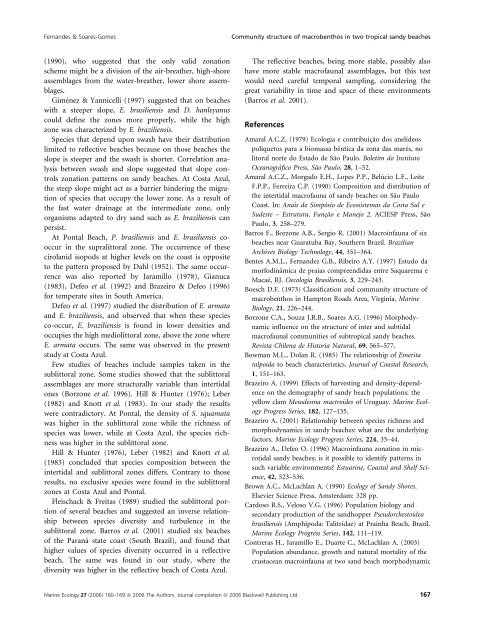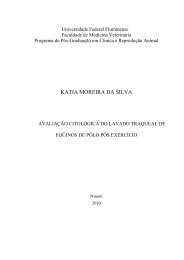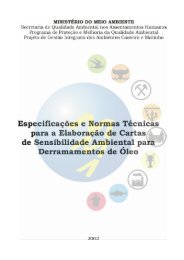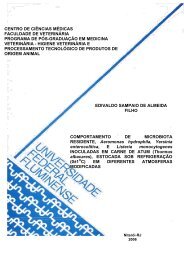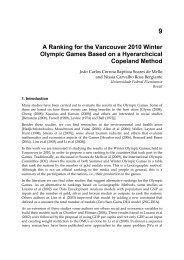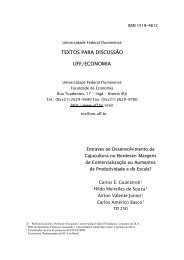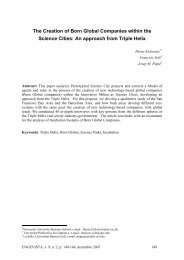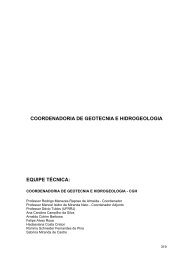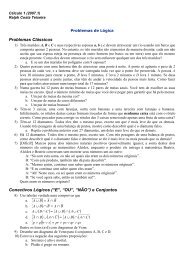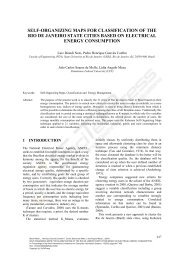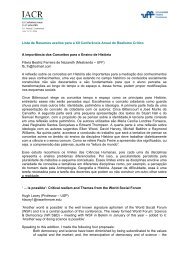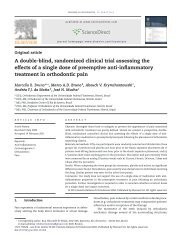Community structure of macrobenthos in two tropical sandy ... - UFF
Community structure of macrobenthos in two tropical sandy ... - UFF
Community structure of macrobenthos in two tropical sandy ... - UFF
You also want an ePaper? Increase the reach of your titles
YUMPU automatically turns print PDFs into web optimized ePapers that Google loves.
Fernandes & Soares-Gomes<br />
<strong>Community</strong> <strong>structure</strong> <strong>of</strong> <strong>macrobenthos</strong> <strong>in</strong> <strong>two</strong> <strong>tropical</strong> <strong>sandy</strong> beaches<br />
(1990), who suggested that the only valid zonation<br />
scheme might be a division <strong>of</strong> the air-breather, high-shore<br />
assemblages from the water-breather, lower shore assemblages.<br />
Giménez & Yannicelli (1997) suggested that on beaches<br />
with a steeper slope, E. brasiliensis and D. hanleyanus<br />
could def<strong>in</strong>e the zones more properly, while the high<br />
zone was characterized by E. braziliensis.<br />
Species that depend upon swash have their distribution<br />
limited to reflective beaches because on those beaches the<br />
slope is steeper and the swash is shorter. Correlation analysis<br />
between swash and slope suggested that slope controls<br />
zonation patterns on <strong>sandy</strong> beaches. At Costa Azul,<br />
the steep slope might act as a barrier h<strong>in</strong>der<strong>in</strong>g the migration<br />
<strong>of</strong> species that occupy the lower zone. As a result <strong>of</strong><br />
the fast water dra<strong>in</strong>age at the <strong>in</strong>termediate zone, only<br />
organisms adapted to dry sand such as E. braziliensis can<br />
persist.<br />
At Pontal Beach, P. brasiliensis and E. brasiliensis cooccur<br />
<strong>in</strong> the supralittoral zone. The occurrence <strong>of</strong> these<br />
cirolanid isopods at higher levels on the coast is opposite<br />
to the pattern proposed by Dahl (1952). The same occurrence<br />
was also reported by Jaramillo (1978), Gianuca<br />
(1983), Defeo et al. (1992) and Brazeiro & Defeo (1996)<br />
for temperate sites <strong>in</strong> South America.<br />
Defeo et al. (1997) studied the distribution <strong>of</strong> E. armata<br />
and E. braziliensis, and observed that when these species<br />
co-occur, E. braziliensis is found <strong>in</strong> lower densities and<br />
occupies the high mediolittoral zone, above the zone where<br />
E. armata occurs. The same was observed <strong>in</strong> the present<br />
study at Costa Azul.<br />
Few studies <strong>of</strong> beaches <strong>in</strong>clude samples taken <strong>in</strong> the<br />
sublittoral zone. Some studies showed that the sublittoral<br />
assemblages are more structurally variable than <strong>in</strong>tertidal<br />
ones (Borzone et al. 1996). Hill & Hunter (1976); Leber<br />
(1982) and Knott et al. (1983). In our study the results<br />
were contradictory. At Pontal, the density <strong>of</strong> S. squamata<br />
was higher <strong>in</strong> the sublittoral zone while the richness <strong>of</strong><br />
species was lower, while at Costa Azul, the species richness<br />
was higher <strong>in</strong> the sublittoral zone.<br />
Hill & Hunter (1976), Leber (1982) and Knott et al.<br />
(1983) concluded that species composition between the<br />
<strong>in</strong>tertidal and sublittoral zones differs. Contrary to those<br />
results, no exclusive species were found <strong>in</strong> the sublittoral<br />
zones at Costa Azul and Pontal.<br />
Fleischack & Freitas (1989) studied the sublittoral portion<br />
<strong>of</strong> several beaches and suggested an <strong>in</strong>verse relationship<br />
between species diversity and turbulence <strong>in</strong> the<br />
sublittoral zone. Barros et al. (2001) studied six beaches<br />
<strong>of</strong> the Paraná state coast (South Brazil), and found that<br />
higher values <strong>of</strong> species diversity occurred <strong>in</strong> a reflective<br />
beach. The same was found <strong>in</strong> our study, where the<br />
diversity was higher <strong>in</strong> the reflective beach <strong>of</strong> Costa Azul.<br />
The reflective beaches, be<strong>in</strong>g more stable, possibly also<br />
have more stable macr<strong>of</strong>aunal assemblages, but this test<br />
would need careful temporal sampl<strong>in</strong>g, consider<strong>in</strong>g the<br />
great variability <strong>in</strong> time and space <strong>of</strong> these environments<br />
(Barros et al. 2001).<br />
References<br />
Amaral A.C.Z. (1979) Ecologia e contribuição dos anelídeos<br />
poliquetos para a biomassa bêntica da zona das marés, no<br />
litoral norte do Estado de São Paulo. Boletim do Instituto<br />
Oceanográfico Press, São Paulo, 28, 1–52.<br />
Amaral A.C.Z., Morgado E.H., Lopes P.P., Belúcio L.F., Leite<br />
F.P.P., Ferreira C.P. (1990) Composition and distribution <strong>of</strong><br />
the <strong>in</strong>tertidal macr<strong>of</strong>auna <strong>of</strong> <strong>sandy</strong> beaches on São Paulo<br />
Coast. In: Anais do Simpósio de Ecossistemas da Costa Sul e<br />
Sudeste – Estrutura, Função e Manejo 2. ACIESP Press, São<br />
Paulo, 3, 258–279.<br />
Barros F., Borzone A.B., Sergio R. (2001) Macro<strong>in</strong>fauna <strong>of</strong> six<br />
beaches near Guaratuba Bay, Southern Brazil. Brazilian<br />
Archives Biology Technology, 44, 351–364.<br />
Bentes A.M.L., Fernandez G.B., Ribeiro A.Y. (1997) Estudo da<br />
morfod<strong>in</strong>âmica de praias compreendidas entre Saquarema e<br />
Macaé, RJ.Oecologia Brasiliensis, 3, 229–243.<br />
Boesch D.F. (1973) Classification and community <strong>structure</strong> <strong>of</strong><br />
<strong>macrobenthos</strong> <strong>in</strong> Hampton Roads Area, Virg<strong>in</strong>ia. Mar<strong>in</strong>e<br />
Biology, 21, 226–244.<br />
Borzone C.A., Souza J.R.B., Soares A.G. (1996) Morphodynamic<br />
<strong>in</strong>fluence on the <strong>structure</strong> <strong>of</strong> <strong>in</strong>ter and subtidal<br />
macr<strong>of</strong>aunal communities <strong>of</strong> sub<strong>tropical</strong> <strong>sandy</strong> beaches.<br />
Revista Chilena de Historia Natural, 69, 565–577.<br />
Bowman M.L., Dolan R. (1985) The relationship <strong>of</strong> Emerita<br />
talpoida to beach characteristics. Journal <strong>of</strong> Coastal Research,<br />
1, 151–163.<br />
Brazeiro A. (1999) Effects <strong>of</strong> harvest<strong>in</strong>g and density-dependence<br />
on the demography <strong>of</strong> <strong>sandy</strong> beach populations: the<br />
yellow clam Mesodesma mactroides <strong>of</strong> Uruguay. Mar<strong>in</strong>e Ecology<br />
Progress Series, 182, 127–135.<br />
Brazeiro A. (2001) Relationship between species richness and<br />
morphodynamics <strong>in</strong> <strong>sandy</strong> beaches: what are the underly<strong>in</strong>g<br />
factors. Mar<strong>in</strong>e Ecology Progress Series, 224, 35–44.<br />
Brazeiro A., Defeo O. (1996) Macro<strong>in</strong>fauna zonation <strong>in</strong> microtidal<br />
<strong>sandy</strong> beaches; is it possible to identify patterns <strong>in</strong><br />
such variable environments? Estuar<strong>in</strong>e, Coastal and Shelf Science,<br />
42, 523–536.<br />
Brown A.C., McLachlan A. (1990) Ecology <strong>of</strong> Sandy Shores.<br />
Elsevier Science Press, Amsterdam: 328 pp.<br />
Cardoso R.S., Veloso V.G. (1996) Population biology and<br />
secondary production <strong>of</strong> the sandhopper Pseudorchestoidea<br />
brasiliensis (Amphipoda: Talitridae) at Pra<strong>in</strong>ha Beach, Brazil.<br />
Mar<strong>in</strong>e Ecology Progress Series, 142, 111–119.<br />
Contreras H., Jaramillo E., Duarte C., McLachlan A. (2003)<br />
Population abundance, growth and natural mortality <strong>of</strong> the<br />
crustacean macro<strong>in</strong>fauna at <strong>two</strong> sand beach morphodynamic<br />
Mar<strong>in</strong>e Ecology 27 (2006) 160–169 ª 2006 The Authors. Journal compilation ª 2006 Blackwell Publish<strong>in</strong>g Ltd 167


